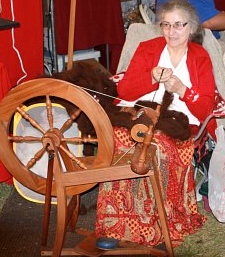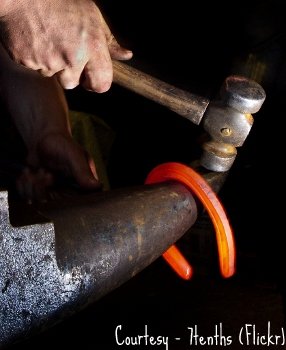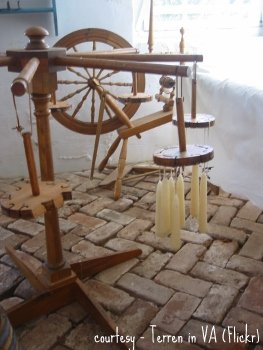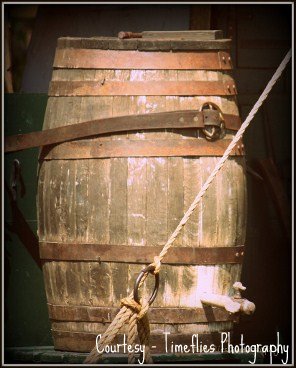Colonial Crafts
1607 - 1776
Colonial Crafts is a story about Artists, Craftsmen, and Tradesmen; much like the pages of Brothers-Handmade. One big difference is, back in the Colonial days (1607-1776) your life depended on those craftsmen. It might not have started in the 1700’s, but it sure got serious then.
In places like Jamestown, Virginia; Plymouth, Massachusetts; and Albany, New York; if you lost your doctor, blacksmith, weaver, farmer, cooper, or carpenter, the list is vast, there was a distinct chance you might not make it. Just ask the folks from Roanoke, Virginia - Oh wait you can’t ask them, they didn’t make it! By the way, the word "Virginia" is the oldest designation of an English claim in North America.
Sir Walter Raleigh established the first British colony in North America, in 1585 on Roanoke Island off the coast of North Carolina. They tried twice in two years and failed. The British tried again 20 years later. This time -- at Jamestown in 1607 – they would succeed, and North America would begin a new era. And eventually name its capitol, Raleigh (after Sir Walter Raleigh).

Today the number of common crafts is slightly less than back in colonial days. Today we typically count between 21 and 30 crafts. In 1702 there were over 100 colonial crafts functioning in daily life. You may not even recognize them by name.
Here are a few:
- ACCIPITRARY - a falconer or keeper and tamer of hawks
- ANTIGROPELOS MAKER - a person who made waterproof leggings
- BARM BREWER: - a person who made yeast
- BIBLIOTHECARY - a librarian
- BIRDS NEST SELLER - a person who sold bird’s nests collected from the wild complete with eggs; these were then hatched by domestic birds and sold as pets
- BRABENER - a weaver
- CADDY BUTCHER - horse meat butcher
- CARTOGRAPHER - a map maker
- CAULKER - a person who made boats watertight by caulking the seams
- FARRIER - a blacksmith or horse-shoer
- FRISEUR - a hairdresser
- JAKES-FARMER - one who emptied cesspools
- LEECH or SAWBONES - physician
- NIMGIMMER - doctor, surgeon, or apothecary
- PETERMAN - a fisherman
- PIGMAN [also MUGGER] - a seller of crockery
- PRICKER - witch hunter
- RATONER - a rat catcher
- SCAVELMAN - one who kept the waterways and ditches clear
- WAINWRIGHT - one who built or repaired wagons
- WHEELWRIGHT - a person who repaired and made wheels and wheeled vehicles
This list of colonial crafts just barely scratches the surface. Back in those days everybody had a specialty. And you can bet they were good at what they did.
Let’s look at the importance of the colonial crafts, trades and arts. The things you needed back then would be somewhat the things you need today (except for the X-Box 360): Shelter, food, water, and sooner or later medical care.
So the neighbors helped you get the log walls cut and stacked up for the house. But you need a roof, and for that you need a “Shingler”. This person made shakes, and the good ones were cedar. He did his work on a break and vice with axe, saw and draw knife. It was long and tedious work. As you can imagine one house would use up a lot. You would need a blacksmith because iron nails would be needed.
In the 1700’s settlers would burn the house down when they moved so as to reclaim nails and any ironwork that was used in the construction.
Iron was that important. Colonial craftsmen wasted very little, and actually were pretty good recyclers. Incidentally iron back then was “wrought iron” and was a porous metal that had a lot of slag in it. Not very strong but very easy to forge. It was an important material to say the least. “Wrought” literally means to work by hand. Thus wrought iron was forged from a bloom of iron and slag, by hand.

Composition of Wrought iron= 99–99.8%/Iron; 0.05–0.25%/Carbon; 0.01–0.1%/Manganese; 0.02–0.1%/Sulfur; 0.05–0.2%/Phosphorous, and 0.02–0.2%/Silicon.
The colonial craftsmen and tradesmen would have to make sure they were done crafting their shelters by winter. That oversight was the single most critical reason for some failures in New England.
Well one would need clothing, plates, bowls, cooking utensils, some sort of storage for foodstuffs, and lighting (oil or candles).
If the lighting choice is an oil lantern, then a tinsmith or brightsmith would be required to make the lamp. If its candle, you would probably make those your self.
 Generally, the women made candles in the fall. That’s when the butchering was done. They rendered tallow and that makes for some smelly candles. But at least you would have light.
Generally, the women made candles in the fall. That’s when the butchering was done. They rendered tallow and that makes for some smelly candles. But at least you would have light.
Did Ben Franklin say “early to bed early to rise makes a man healthy wealthy and wise”? I suppose Deborah (Ben’s wife) didn’t want to smell the candles. And that is more likely why they were in bed early. And if Deborah is happy, that’s healthy and wise for Ben!

You would need a
Cooper to make barrels to store your grains and foodstuffs. Storage would be of extreme importance as winter is coming. Don’t forget, mice have to eat also and the food you stored would suit them fine. It would have been very important that mice and insects be kept out of the food!
Most women did their own sewing, but they bought a lot of their material. A Milliner was a woman who bought and sold cloth and clothing. She would need a spinner and a weaver as well. It’s easy to see how everyone’s lives were tied together.
So now you need shoes. Moccasins were big in those days. The men made them out of whatever hides they had. Deer were the most common. For a little more upscale one would use a Cobbler. This was truly a colonial craft, as it is today. The Cobbler used mostly cowhide for shoes.
Most of the children followed in their parents’ footsteps. If your father was a Carpenter you were a Carpenter. If he was an Apothecary then chances are you would end up being a druggist too. I can only imagine what the women would think if they would know what handmade soap and quilts were worth today. I doubt they would believe it.
So from humble beginnings, colonial crafts turned into American industry and 100 years after that it went crazy around here. But that’s another story.
They say small business and small industry is the backbone of America. Believe me, you can't get much closer to this truth than when you're with the great Craftsmen and Artists that we'll introduce you to on this website. Until we meet again, remember, American Manufacturing is alive and well at Brothers-Handmade. Come see what your neighbors are making.
Return from Colonial Crafts to Handmade Soap